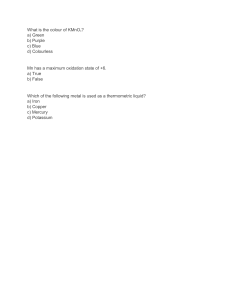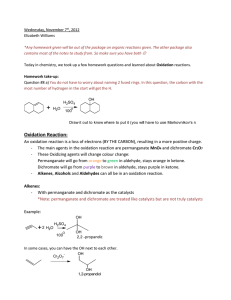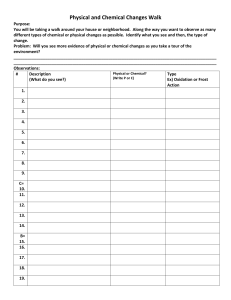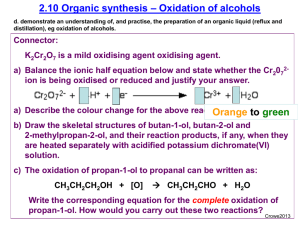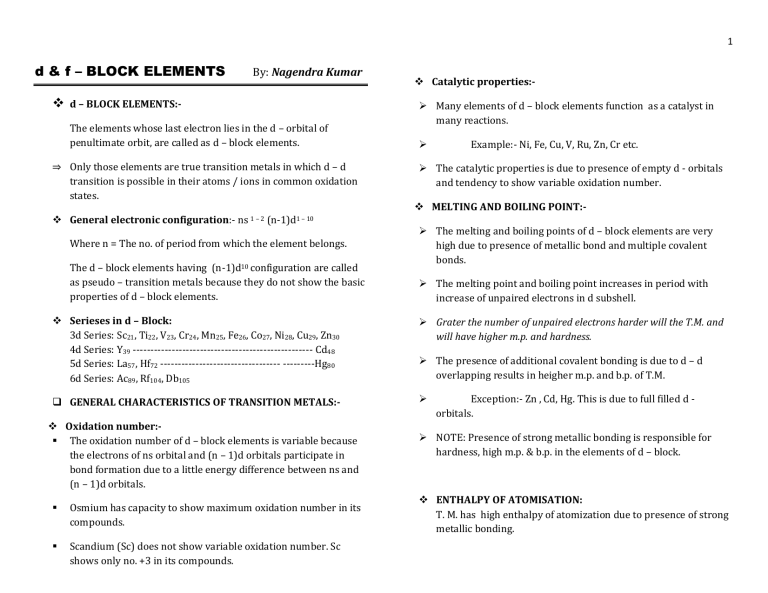
1 d & f – BLOCK ELEMENTS ❖ By: Nagendra Kumar d – BLOCK ELEMENTS:The elements whose last electron lies in the d – orbital of penultimate orbit, are called as d – block elements. ⇒ Only those elements are true transition metals in which d – d transition is possible in their atoms / ions in common oxidation states. ❖ General electronic configuration:- ns 1 – 2 (n-1)d1 – 10 Where n = The no. of period from which the element belongs. The d – block elements having (n-1)d10 configuration are called as pseudo – transition metals because they do not show the basic properties of d – block elements. ❖ Catalytic properties:➢ Many elements of d – block elements function as a catalyst in many reactions. ➢ Example:- Ni, Fe, Cu, V, Ru, Zn, Cr etc. ➢ The catalytic properties is due to presence of empty d - orbitals and tendency to show variable oxidation number. ❖ MELTING AND BOILING POINT:➢ The melting and boiling points of d – block elements are very high due to presence of metallic bond and multiple covalent bonds. ➢ The melting point and boiling point increases in period with increase of unpaired electrons in d subshell. ❖ Serieses in d – Block: 3d Series: Sc21, Ti22, V23, Cr24, Mn25, Fe26, Co27, Ni28, Cu29, Zn30 4d Series: Y39 --------------------------------------------------- Cd48 5d Series: La57, Hf72 ---------------------------------- ---------Hg80 6d Series: Ac89, Rf104, Db105 ➢ Grater the number of unpaired electrons harder will the T.M. and will have higher m.p. and hardness. ❑ GENERAL CHARACTERISTICS OF TRANSITION METALS:- ➢ ❖ Oxidation number:▪ The oxidation number of d – block elements is variable because the electrons of ns orbital and (n – 1)d orbitals participate in bond formation due to a little energy difference between ns and (n – 1)d orbitals. ▪ Osmium has capacity to show maximum oxidation number in its compounds. ▪ Scandium (Sc) does not show variable oxidation number. Sc shows only no. +3 in its compounds. ➢ The presence of additional covalent bonding is due to d – d overlapping results in heigher m.p. and b.p. of T.M. Exception:- Zn , Cd, Hg. This is due to full filled d orbitals. ➢ NOTE: Presence of strong metallic bonding is responsible for hardness, high m.p. & b.p. in the elements of d – block. ❖ ENTHALPY OF ATOMISATION: T. M. has high enthalpy of atomization due to presence of strong metallic bonding. 2 Greater the number of unpaired electrons, stronger will be the metallic bonds and greater will be the enthalpy of atomization. ❖ MAGNETIC PROPERTIES: ▪ High charge density. Ex.: [Ag (NH3)2]+ ❖ ALLOY FORMATION:- The element having any unpaired electron in their atom/ion will be paramagnetic. [Fe, Co & Ni = Ferromagnetic] They form alloy due to similar atomic size. Metals can replace each other in the crystal and form alloys. The element having no unpaired electron in their atom/ion will be diamagnetic. The magnetic moment can be expressed as μ = √n(n +2) BM where n = No. of unpared electrons. ❖ FORMATION OF COLOURED COMPOUNDS:▪ ▪ ▪ All the elements of d – block which has (n - 1)d1-9 configuration form coloured ions due to presence of unpaired electrons.They can under go d-d transition by absorbing colour from the visible region and radiate complimentary colour. All the elements of d – block which has (n -1)d0/10 configuration are colourless. In some cases the configuration is d0/10 like KMnO4 (Purple)/ K2Cr2O7 (orange colour) still the compound is coloured due to charge transfer. ❖ FORMATION OF COMPLEXES:▪ Transition metals forms complexes due to the following reasons:- ▪ Presence of vacant orbitals of suitable energy. ▪ Smaller size. Ex.:- Brass, Bronze, Steel etc. ❖ FORMATION OF INTERSTITIAL COMPOUNDS: ▪ The substance formed by mixing non metals in the crystals of the metals of d – block is called as interstitial compound. Ex. : Fe3C. ➢ The interstitial spaces in the crystal of transition metal are so sufficient that the small atoms of nonmetals can easily adjusted so transition metals can form interstitial compounds. ➢ Characteristics of interstitial compounds: ▪ They are generally harder than the parent metal. ▪ They are inert than the parent metal. ▪ They have higher m.p. and b.p. than the parent metal. ▪ They are good conductor of heat and electricity. ❖ POTASSIUM PERMANGANATE: ▪ Molecular formula: KMnO4 ❖ Preparation: ▪ On large scale it is prepared from mineral pyrolusite (MnO 2). The manufacture involves the following steps: 3 ➢ Step 1: Conversion of MnO2 into Potassium manganate: MnO2 + KOH + O2 / KNO3 / KClO3 K2MnO4 + H2O + KNO2 / KCl ➢ Step 2: Oxidation of Potassium manganate into Potassium permanganate: 2 K2MnO4 + Cl2 ▪ A neutral or slightly basic solution of permanganate solution oxidizes thiosulphate to sulphate. iodide to iodate. S2O32⁻ / I⁻ + MnO4⁻ + H2O ▪ A neutral solution of permanganate solution oxidizes magnous salt to MnO2. 2 KMnO4 + MnO2 + 2 KCl When the oxidation is complete, the solution is filtered and evaporated under controlled condition of temperature to obtain Potassium permanganate. SO42⁻ / IO3⁻/ + OH⁻ + MnO2 3Mn+ + 2MnO4⁻ + H2O ▪ 5MnO2 + 4H+ Structure: ❖ PHYSICAL PROPERTIES: ▪ On heating it is get decomposed to potassium manganate and release oxygen. 2KMnO4 K2MnO4 + MnO2 + O2 ❖ USES ❖ CHEMICAL PROPERTIES: ▪ It is good oxidizing agent in acidic, basic and neutral medium. ❖ Oxidising property in acidic medium: ▪ Acidified permanganate solution oxidizes oxalate to carbon dioxide. 5 (COOˉ)2 + MnO4⁻ + 16 H+ ▪ 10 CO2 + 2Mn2+ + 8 H2O Acidified permanganate solution oxidizes Fe2+ to Fe3+. 5 Fe2+ + MnO4⁻ + 8 H+ 4 H2O + Mn2+ + 5 Fe3+ ❖ Oxidizing property in neutral or basic medium: ▪ It is used in analytic chemistry. ▪ It is used as an oxidant in organic chemistry. ▪ It is used as bleaching agent for wool, cotton, silk, oil. ❑ POTASSIUM DICHROMATE ▪ Molecular formula: K2Cr2O7 ❖ MANUFACTURE : It is prepared from chromite ore (FeO . Cr2O3). The following steps are involved in the manufacture of potassium dichromate from the chromite ore: ➢ Step 1: Preparation of sodium chromate: 4 4 FeO.Cr2O3 + 8Na2CO3 + 7O2 8CO2 8 Na2CrO4 + 2 Fe2O3 + ❖ Orange coloured K2Cr2O7 solution on reaction with basic NaOH gets converted to chromate which is yellow in colour. K2Cr2O7 + 2 NaOH ➢ Step 2:Conversion of sodium chromate to sodium dichromate: 2Na2CrO4 + Conc. H2SO4 Na2Cr2O7 + Na2SO4 + H2O ➢ Step 3: Conversion of sodium dichromate into potassium dichromate: Na2Cr2O7 + 2 KCl K2Cr2O7 + 2NaCl K2CrO4 + NaCrO4 + H2O ❖ USES: ▪ It is a good oxdising agent. ▪ It is used in tanning of leather. ▪ It is used as disinfectant. ❖ Structure of dichromate ion: ❖ PHYSICAL PROPERTIES: ▪ Action of heat: On heating it is get decomposed to potassium chromate and releases oxygen. 4 K2Cr2O7 4K2CrO4 + 2Cr2O3 + 3O2 ❖ CHEMICAL PROPERTIES: ▪ It is strong oxidizing agent. In acidic medium. It is get reduced as follows: Cr2O72ˉ + 14H⁺ ▪ ▪ ▪ It oxidizes iodide to iodine. Cr2O72ˉ + 14H⁺ + 6Iˉ 2Cr3⁺ + 7H2O It oxidizes ferrous ion to ferric ion. Cr2O72ˉ + 14H⁺ + 6Fe2⁺ f – BLOCK ELEMENTS 2Cr3⁺ + 7H2O 2Cr3⁺ + 7H2O + 6Fe3⁺ The elements having their last electron in the f – subshell of antipenultimate shell are called as f – block elements. ❖ General electronic configuration: ns1 – 2 (n – 1 )d0/1 (n – 2)f1 – 14 ❖ Location of f – block in P. T. : f – Block is located at the base of the P.T. ❖ CLASSIFICATION OF F – BLOCK ELEMENTS: 5 ▪ Lanthanides / 4f – series: ▪ Actinides / 5f – series: 58Ce 90Th ------------- 71Lu ---------------103Lr ❑ LANTHANIDES: ▪ All the elements present In lanthanide series are called as lanthanides. General electronic configuration: 6s1 – 2 5d0/1 4f1 – 14 ▪ Except Promethium (Pm) all are non radioactive elements. ✓ DIFFERENCE BETWEEN LANTHENIDES AND ACTINIDES: ❖ Lanthanide contraction: 4f – subshell in the lanthanides is either partially or completely filled. The electrons of 4f – subsell show small repulsion due to poor shielding effect so the effective nuclear charge experienced is more than the expected value and leads in contraction of atomic size called as lanthanide contraction. ❑ ACTINIDES: ▪ ▪ • • • All the elements present In actinide series are called as actinides. General electronic configuration: 7s1 – 2 6d0/1 5f1 – 14 ❖ Characteristics of actinide series: ▪ • All the elements of actinide series are radioactive. ✓ Lanthanide contraction: 4f subshell of the actinides is completely filled and 5f – subshell in the actinides is either partially or completely filled. The electrons of 4f & 5f – subsell show small repulsion due to poor shielding effect so the effective nuclear charge experienced is more than the expected value and leads in contraction of atomic size called as actinide contraction. • LATHENIDES The last electron is present in 4f subshell. They show +2, +3 and +5 oxidation state. All the elements except Pm are non radioactive. Their magnetic properties can be easily explained. Their oxides are relatively less basic. • • • • • ACTINIDES The last electron is present in 5f subshell. They show +3, +4 and +5 oxidation state. All the elements are radioactive. Their magnetic properties can ‘t be easily explained. Their oxides are more basic.
